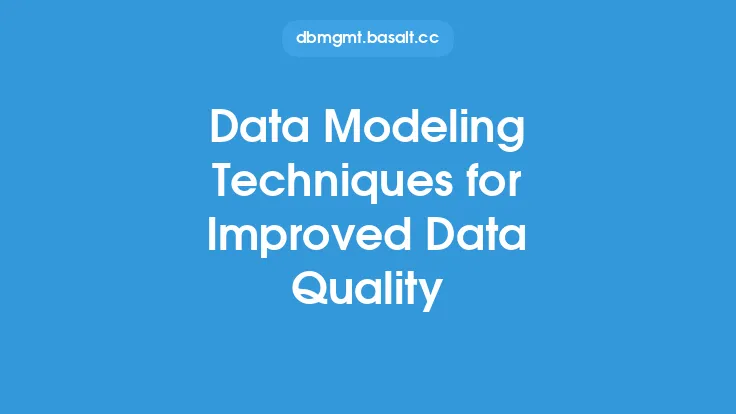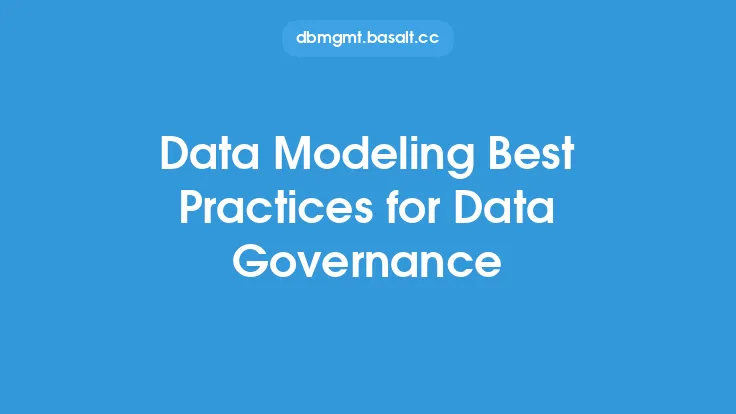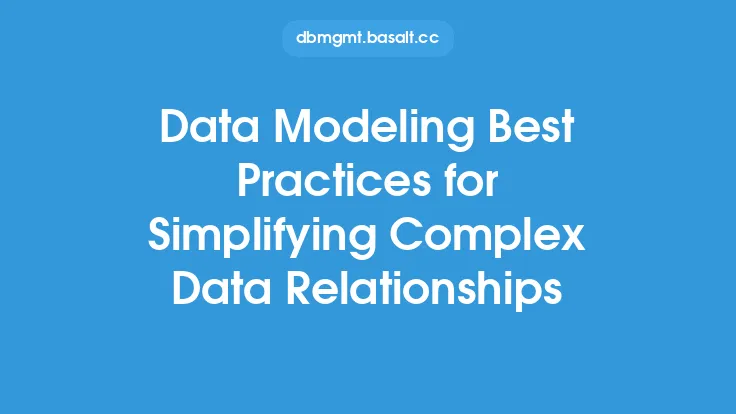Data modeling is a crucial step in the data management process, as it enables organizations to create a conceptual representation of their data assets. A well-designed data model is essential for ensuring data quality, as it provides a framework for organizing, storing, and retrieving data in a consistent and efficient manner. In this article, we will discuss the best practices for data modeling that can help improve data quality.
Introduction to Data Modeling
Data modeling involves creating a visual representation of an organization's data assets, including entities, attributes, and relationships. The goal of data modeling is to create a conceptual framework that accurately reflects the organization's business requirements and data needs. A good data model should be able to capture the complexity of the organization's data assets, while also providing a simple and intuitive way to understand and interact with the data.
Data Modeling Principles
There are several key principles that should guide the data modeling process. First, the data model should be based on a clear understanding of the organization's business requirements and data needs. This involves gathering input from stakeholders and subject matter experts to ensure that the data model accurately reflects the organization's data assets. Second, the data model should be designed to be flexible and adaptable, as the organization's data needs are likely to evolve over time. Third, the data model should be based on a standardized set of data elements and definitions, to ensure consistency and accuracy across the organization.
Entity-Relationship Modeling
Entity-relationship modeling is a fundamental concept in data modeling, as it provides a way to represent the relationships between different data entities. In entity-relationship modeling, entities are represented as tables or objects, and relationships are represented as lines or connections between the entities. There are several types of relationships that can exist between entities, including one-to-one, one-to-many, and many-to-many relationships. Understanding these relationships is critical to creating a well-designed data model.
Data Normalization
Data normalization is the process of organizing data in a database to minimize data redundancy and dependency. Normalization involves dividing large tables into smaller tables, and defining relationships between them. There are several levels of normalization, including first normal form (1NF), second normal form (2NF), and third normal form (3NF). Each level of normalization provides a higher level of data integrity and scalability, but also increases the complexity of the data model.
Data Attribute Definition
Data attribute definition is the process of defining the characteristics of each data element, including data type, length, and format. Accurate data attribute definition is critical to ensuring data quality, as it provides a clear understanding of what each data element represents and how it should be used. Data attribute definition should be based on a standardized set of data elements and definitions, to ensure consistency and accuracy across the organization.
Data Relationship Definition
Data relationship definition is the process of defining the relationships between different data entities. Accurate data relationship definition is critical to ensuring data quality, as it provides a clear understanding of how different data entities are related and how they should be used. Data relationship definition should be based on a clear understanding of the organization's business requirements and data needs, and should be designed to be flexible and adaptable.
Data Model Validation
Data model validation is the process of verifying that the data model accurately reflects the organization's business requirements and data needs. Validation involves checking the data model against a set of predefined rules and constraints, to ensure that it is consistent and accurate. Data model validation should be performed on a regular basis, to ensure that the data model remains relevant and effective over time.
Data Model Maintenance
Data model maintenance is the process of updating and refining the data model over time, to ensure that it remains relevant and effective. Maintenance involves monitoring the data model for changes and updates, and making adjustments as needed. Data model maintenance should be performed on a regular basis, to ensure that the data model remains aligned with the organization's business requirements and data needs.
Best Practices for Data Modeling
There are several best practices that can help improve data quality through data modeling. First, the data model should be based on a clear understanding of the organization's business requirements and data needs. Second, the data model should be designed to be flexible and adaptable, as the organization's data needs are likely to evolve over time. Third, the data model should be based on a standardized set of data elements and definitions, to ensure consistency and accuracy across the organization. Fourth, the data model should be validated and maintained on a regular basis, to ensure that it remains relevant and effective over time.
Conclusion
In conclusion, data modeling is a critical step in the data management process, as it enables organizations to create a conceptual representation of their data assets. A well-designed data model is essential for ensuring data quality, as it provides a framework for organizing, storing, and retrieving data in a consistent and efficient manner. By following the best practices outlined in this article, organizations can create a data model that is flexible, adaptable, and aligned with their business requirements and data needs.





